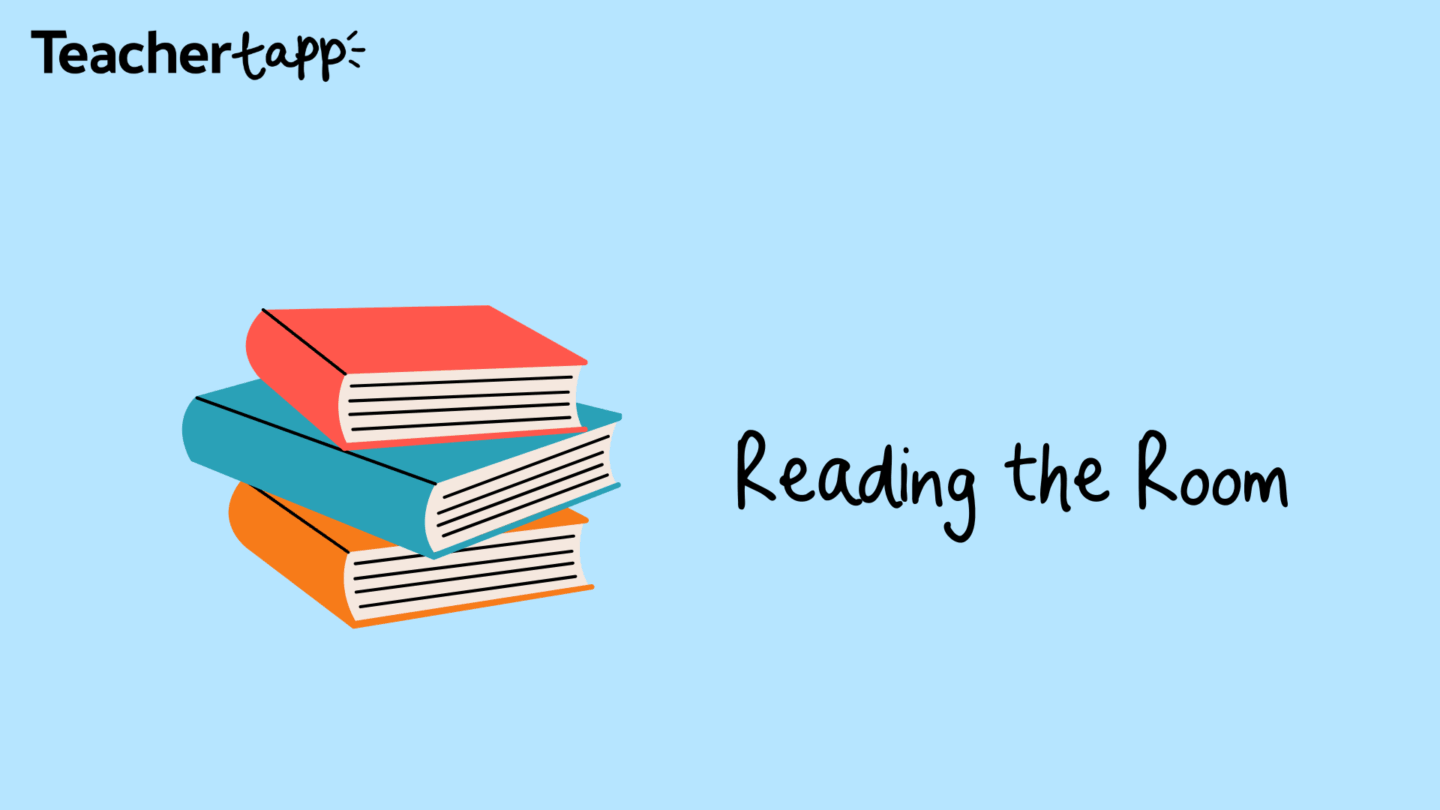
Hey Teacher Tapp Community!
It’s Week 28—and that means another amazing round of insights from our ever-growing Teacher Tapp community!
Want to help Teacher Tapp grow?
👥 Invite your colleagues to join!
The best link to share is onelink.to/teachertapp — it takes them straight to the app store! 📲✨
📌 Share us in your teacher lounge!
Print this poster and pin it up in your breakroom to help spread the word.
💬 We’d love your feedback!
What do you love about the app? What could be better? Let us know by emailing usa@teachertapp.com — we’re all ears!
Now, time for the edu-data!
1. AI, schools and presidential orders
This week, stories circulated about presidential orders on how AI is used in schools. As yet, nothing is confirmed – but how confident are teachers in teaching AI now? And who do teachers think should be the one to decide how AI is used by educators?
High school teachers are the most confident in their AI skills, with almost one in five (19%) describing themselves as ‘very confident’. Middle teachers are slightly less confident in comparison, with 16% saying they are ‘very confident’ and elementary teachers are the least confident (11%).
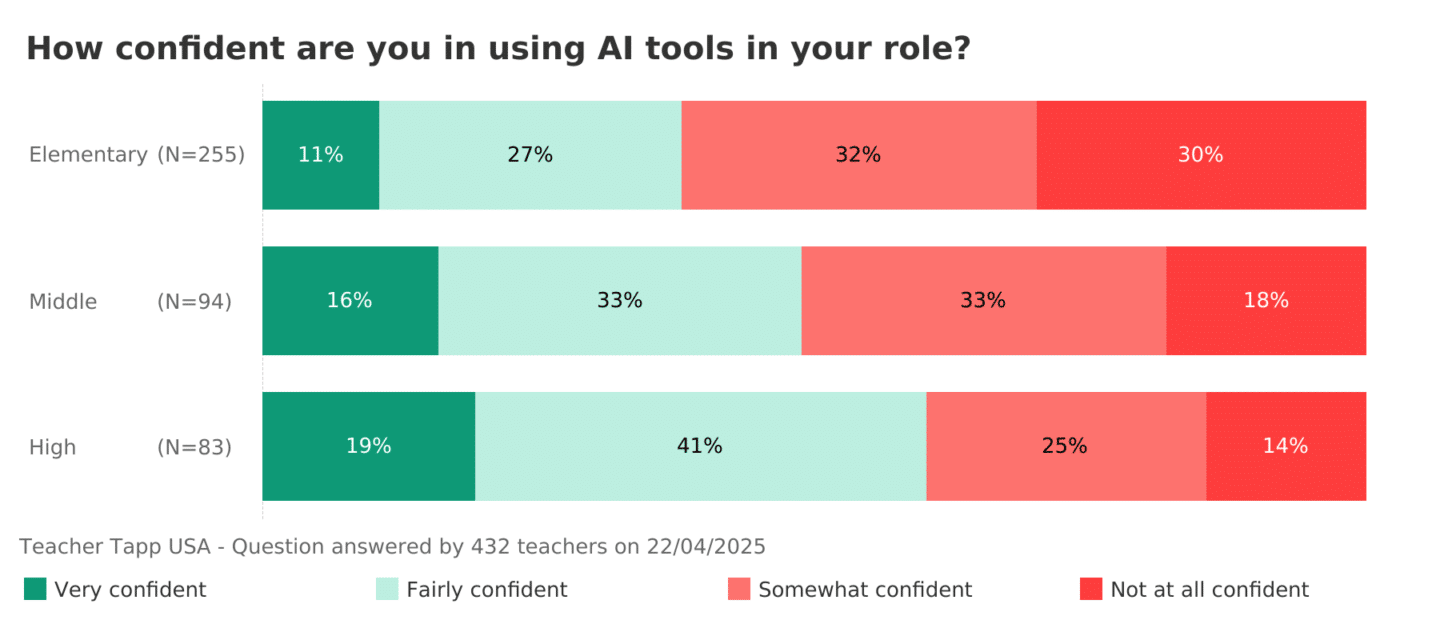
Who decides how AI is used?
Teachers say it is teachers who should make the decisions about how AI is used in the classroom – this is true for 48% of elementary teachers, 44% of middle school teachers and 47% of high school teachers.
School district was the next most common response with 31% of elementary teachers, 45% of middle school teachers (more popular than individual teachers) and 31% of high school teachers.
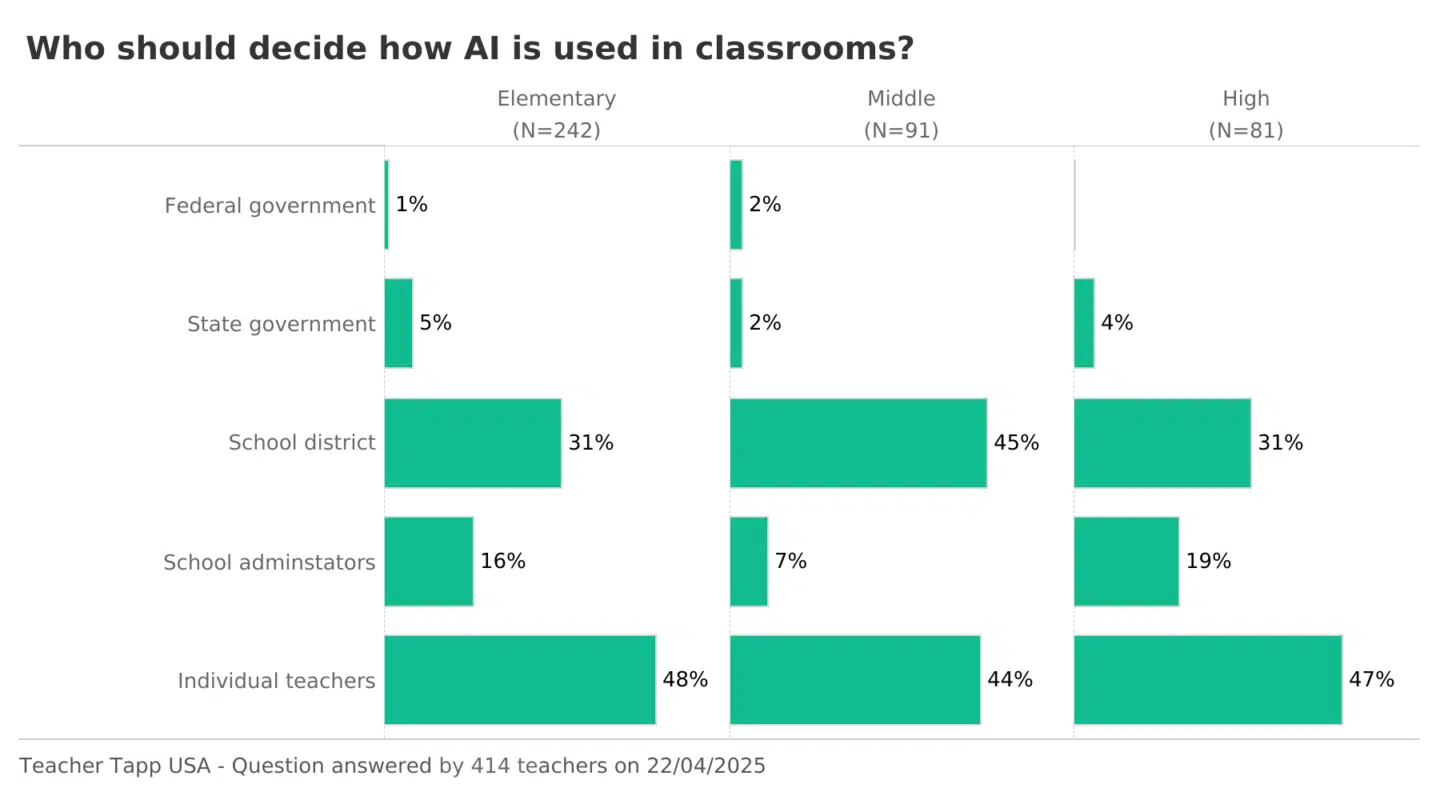
However – do these feelings change among those who are more familiar with AI? Afterall, if a teacher is already ‘very confident’ in their AI skills, how might their opinions differ from those who don’t feel confident?
The answer is: it doesn’t. Teachers who are adept at using AI are just as likely to think teachers should be the ones to decide how AI is used in the classroom when compared to teachers who are not confident in using AI (46% and 45%).
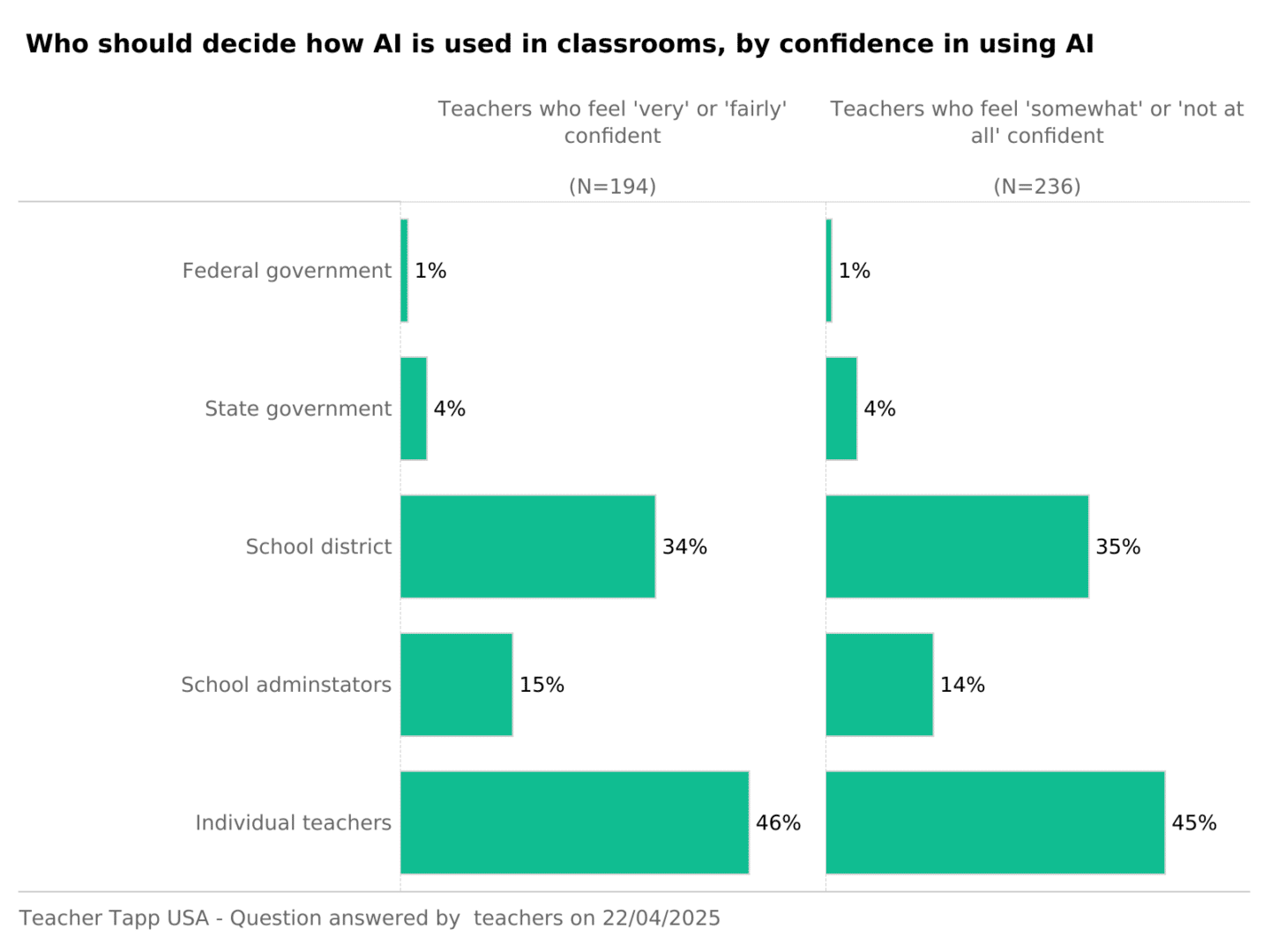
Finally, do teachers believe the federal government can design effective AI training that truly benefits students?
For most, the answer is a firm no. The following percentages of teachers responded not at all to the question of whether they’re confident in the government’s ability to deliver on this:
- 69% of high school teachers
- 63% of middle school teachers
- 62% of elementary school teachers
Do you have more questions you would like us to ask on AI? Get in touch through ‘contact us’ in the app – we would love to hear your ideas.
2. Science fairs
We love when Teacher Tappers send in great question ideas — and last week, one really stood out: science fairs!
🔬 Here’s what we found:
- 25% of U.S. schools currently host a science fair.
- 22% used to, but don’t anymore.
🧑🔬 Science fairs are more often optional (18%) than required (7%), and they’re equally popular in elementary, middle, and high schools.
But how do we compare to other countries?
In England, science fairs are much less common—only 9% of schools run one right now.
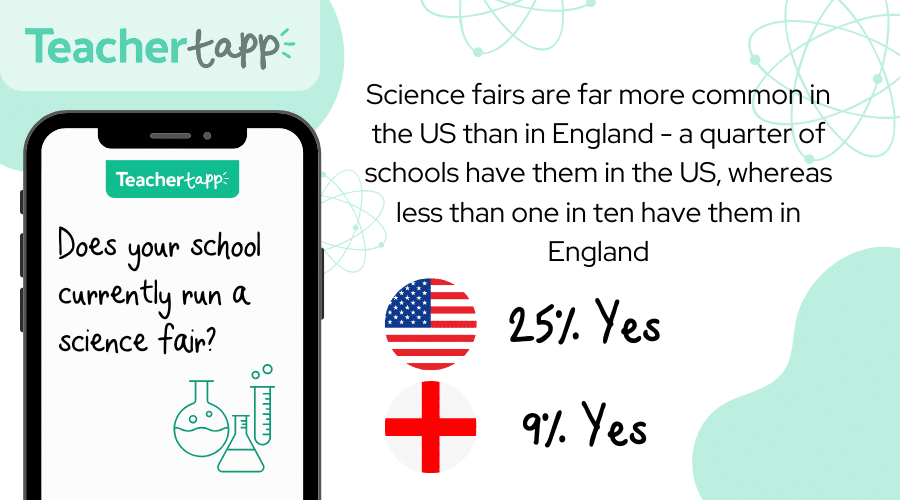
3. What would really improve our schools?
If you could wave a magic wand and fix your school, what would you change?
There were 245 responses to this question (wow!) and they were nothing short of impassioned, insightful, and sometimes heart-wrenching. While each school community has its own unique needs, there were clearly common themes. Here’s what teachers told us—and what it says about the challenges schools are facing today.
1. Student Behavior and Discipline: A Tipping Point
The most frequently mentioned issue? Student behavior. Teachers are deeply concerned about disruptive conduct in classrooms, and many feel that consistent, effective discipline is either absent or undermined. They want systems that not only hold students accountable but also help them learn how to behave respectfully and engage with their education.
“Create and enforce a school-wide discipline policy.”
This points to a growing sense that classroom environments are becoming unmanageable, and that behavior challenges — especially when unsupported — are a major barrier to learning.
2. Supportive Leadership and Administrative Reform
Dozens of teachers called for changes in school leadership. Many said their administrators were out of touch, unsupportive, or even harmful to school culture. A desire for leadership that listens, supports staff, and prioritizes student learning over bureaucracy came through loud and clear.
“Make administration more caring.”
This feedback underscores a trust gap between educators and administrators, and a need to rebuild professional relationships rooted in respect, autonomy, and shared vision.
3. Fair Pay and Resources: We’re Still Not There
Compensation was another dominant theme. Teachers want higher salaries—not only for themselves but for all staff who directly support students. They also highlighted the need for more funding for classroom supplies, facilities, and specialist programs.
“Provide every teacher with what they need to teach.”
It’s clear that underfunding remains a systemic issue. Teachers are still paying out of pocket, working long hours, and being stretched too thin across responsibilities that go well beyond instruction.
4. Facilities and Environment: Clean, Safe, and Functional
Many teachers expressed frustration about outdated or deteriorating school buildings. From leaking roofs to mold, broken HVAC systems, and overcrowded classrooms, the physical environment of schools is weighing heavily on staff and students.
“Fix the decrepit building.”
Poor physical conditions don’t just impact morale — they send a message to staff and students about their value. Teachers want facilities that support a safe, calm, and inspiring place to learn.
5. Parent Accountability and Family Engagement
Several responses pointed to a need for greater parent involvement — not just in volunteering or helping with homework, but in supporting behavior expectations and student learning at home.
“Teach parents to actually parent and discipline their kids.”
This call isn’t about blame — it’s about partnership. Teachers feel they’re often bearing the full weight of student development without adequate reinforcement from families or systems.
6. Curriculum, Testing, and Professional Autonomy
Teachers also voiced concerns about over-standardization and a loss of autonomy. Many want fewer mandated tests, more creativity in the curriculum, and trust in their professional judgment.
“Throw out standardized testing and let teachers teach.”
This echoes a broader debate about the purpose of education and how to balance accountability with meaningful, individualized learning.
What this tells us about U.S. schools today
These reflections paint a sobering but hopeful picture. Teachers care deeply about their students, their schools, and their profession. But they’re operating in environments that are often underfunded, poorly managed, and overwhelmed with behavioral and systemic challenges.
The insights from these open responses are clear: If we want to retain great educators and create thriving school communities, we need to listen to teachers — and act on what they’re telling us. Fortunately, we can amplify your voices with Teacher Tapp and correct the narrative when it comes to education.
Daily Reads
We know lots of teachers on Teacher Tapp LOVE the daily reads! If you have ideas of reads we could feature, get in touch by emailing usa@teachertapp.com and we will check it out!
This week our most-read blog was all about curriculum reform.
